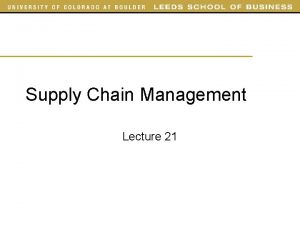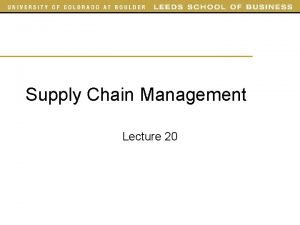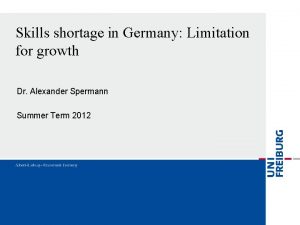Skills shortage in Germany Limitation for growth Dr






















- Slides: 22

Skills shortage in Germany: Limitation for growth Dr. Alexander Spermann Summer Term 2012

Lots of good labor market news • All time high: About 41 millions in jobs (half of population) • Unemployment rate: 6. 5 % (lowest level since 20 years) • Full employment in some regions • More vacancies in dual education system than applicants in most regional labor markets • Germany is now perceived as „champion of flexibility“ (Economist, October 7 th, 2010) • Germany is admired for its „job miracle“ 10/26/2020 2

Structural issue: Demographic Change Demography in Germany: Higher life expectancy plus low birth rate Less inhabitants: instead of 82 millions only 58 millions in 2060, but that‘s not a problem • Core issue: one third has to work for two thirds Repercussions for social security systems, but also for skills shortage 10/26/2020 3

Skills shortage and a typical German reaction Skills shortage • Reduces GDP growth rate • Reduces income „Angst“: „We‘ll get poorer“ 10/26/2020 4

However, surprising voices came up this year Repercussion for the labor market – not that bad: • Skilled labor shortage pushes wages up • Better employment security • Lower unemployment rate „The future will be fun for talents“ 10/26/2020 5

Hypothesis „Skills shortages are a self-made problem. Therefore, institutional reforms can solve it. “ 10/26/2020 6

80 s/90 s: Lump-of-labor fallacy 10/26/2020 7

. . . distribute the „cake“ 10/26/2020 8

Wrong paradigm leads to wrong labor market institutions for the elderly. . . 10/26/2020 9

. . . , wrong incentives for women 10/26/2020 10

. . . and labor migrants 10/26/2020 11

Since 2000: Right paradigm on EU-level, but not yet completely understood by policymakers • More people searching for jobs does not automatically mean more unemployed • Instead: Higher participation rates could be associated with lower unemployment • Germany since 2005: Lower structural unemployment rate 10/26/2020 12

How to solve the skills shortage problem 1) Elderly: Longer working life 2) Women: Higher participation rate and hours worked 3) Migrants: More and higher skilled 4) Education and further training 10/26/2020 13

Solutions 1) Elderly: Longer working life 10/26/2020 14

Employment / population ratio for the elderly (55– 64) Lisbon target Sweden: 70. 6 % in 2010 Iceland: 80. 5 % in 2010 Source: OECD Employment and Labour Market Statistics, Last Update: 31 August 2011 10/26/2020 15

Solutions 2) Women: Higher participation rate and hours worked 10/26/2020 16

Female Employment / population ratio Lisbon target Iceland: 77 % in 2010 Switzerland: 72. 3 % in 2010 Source: OECD Employment and Labour Market Statistics, Last Update: 31 August 2011 10/26/2020 17

Solutions 3) Migrants: More and higher skilled 10/26/2020 18

On the right track in 2011/2012 • Full access to German labor market for 8 MOELcountries as of May 1 st, 2011 • Simplified acceptance of foreign qualifications (March 2012) • Simplified EU-Blue Card immigration (cabinet decision 2011) • Consensus Group „Skills shortage and immigration“ recommends: 30, 000 immigrants each year independent on job offer Germany is on its long way to a real „welcome culture“. 10/26/2020 19

Solutions 4) Education and further training 10/26/2020 20

Skill specific unemployment rates IAB (2011): IAB Aktuell vom 10. 02. 2011 10/26/2020 21

5. Conclusion • German „Angst“ is predominant with respect to structural issues such as demographic change • Skills shortage is perceived as a threat rather than a selfmade problem to be tackled • But less GDP per head is not deterministic • Germany needs higher participation rates for the elderly and women as well as skilled migrants from within Germany, from EU-countries and Non-EU-countries. • Productivity shifts are the main solution: Education, life-long further training and innovation will allow for economic growth 10/26/2020 22
 How do outsiders view esperanza’s neighborhood?
How do outsiders view esperanza’s neighborhood? Supply n demand
Supply n demand What is economics
What is economics Is there a teacher shortage in georgia
Is there a teacher shortage in georgia Pico question for nurse retention
Pico question for nurse retention Kilala din bilang minimum price policy
Kilala din bilang minimum price policy Shortage artinya
Shortage artinya Surplus, and shortage graph
Surplus, and shortage graph Expected shortage per replenishment cycle
Expected shortage per replenishment cycle Impact of supply uncertainty on safety inventory
Impact of supply uncertainty on safety inventory Kurva surplus dan shortage
Kurva surplus dan shortage House on mango street elenita
House on mango street elenita Da pam 710-2-1
Da pam 710-2-1 Inventory pooling
Inventory pooling Expected shortage per replenishment cycle
Expected shortage per replenishment cycle Is fashion objective
Is fashion objective Expected shortage per replenishment cycle
Expected shortage per replenishment cycle Letter of protest format
Letter of protest format Transistor shortage
Transistor shortage Organic growth vs inorganic growth
Organic growth vs inorganic growth What is growth analysis
What is growth analysis Vascular ray
Vascular ray Monocot vs eudicot
Monocot vs eudicot











































